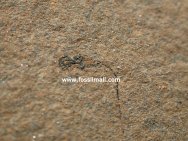|  This
small fossil fish has been the cause of controversy since two cousins
named Gunn first discovered it in 1890. It comes primarily from
this single location, with a few found at two nearby locations as
well. Not only is it Diminitive, but it has structures unlike that
found on most other fish. It possesses a strange basket-like apparatus
on its snout, a well-developed cartilaginous vertebral column (hence
the generic name), but no apparent fins. A prominent feature of
the head of every specimen is a pair of unusual rods termed the
occipital lamellae. These are identical with the cranial ribs found
on lungfish. The only lungfish so far known from these deposits
is the 30-centimeter long Dipterus valenciennsi, for which the smallest
examples are about 60 millimeters in length. If the rostral apparatus
of This
small fossil fish has been the cause of controversy since two cousins
named Gunn first discovered it in 1890. It comes primarily from
this single location, with a few found at two nearby locations as
well. Not only is it Diminitive, but it has structures unlike that
found on most other fish. It possesses a strange basket-like apparatus
on its snout, a well-developed cartilaginous vertebral column (hence
the generic name), but no apparent fins. A prominent feature of
the head of every specimen is a pair of unusual rods termed the
occipital lamellae. These are identical with the cranial ribs found
on lungfish. The only lungfish so far known from these deposits
is the 30-centimeter long Dipterus valenciennsi, for which the smallest
examples are about 60 millimeters in length. If the rostral apparatus
of  Palaeospondylus
is interpreted as a larval attachment organ, then it may well be
the larva of Dipterus. Palaeospondylus
is interpreted as a larval attachment organ, then it may well be
the larva of Dipterus.
Recent studies
seem to confirm Palaeospondylus to be a lungfish, but why is it
so different in appearance from Dipterus? The current thinking is
that it underwent a sharp metamorphosis, rather than a gradual transition
from juvenile to adult. Some researchers prefer to attribute the
anterior attachment organ with those of lampreys, arguing for Palaeospondylus
as a parasite. Whichever the case: oldest known fossil vertebrate
larva or oldest known vertebrate parasite, Palaespondylus gunni
is a unique example of the early lives of fish on this planet.
|